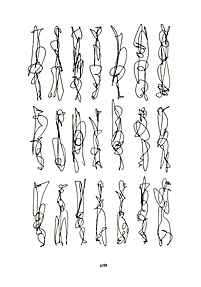|
Axel Malik was born
in 1953. Since 1989 he has written diaries. Everyday, his pen leaves rows
of small, condensed traces of writing on the paper, which he terms «signs».
Each «sign» is a confirmation of events of great intensity.
Although they have no significance from a linguistic point of view, these
lines can be «read» by tracing. As traces of writing movements
the signs mean nothing more than the simple writing movements themselves.
They have no significance beyond their own presence. Even though Malik
did not work with paint, it is possible to speak here of abstract characters
which are auto-referential in the same way as are abstract painting. Malik’s
terrain is that of the no-man’s-land between writing/script and pictures/images.
There are books and scrolls as well as picture formats which given their
exceptional width and length are reminiscent of inscribed banners. When
looking at such «pictures» from varying distances, sometimes
you see writing and sometimes a picture. From afar, an undulating, inconsequential
length of woven cloth with writing seems to be a picture but closer up
it takes on the appearance of horizontal script, i.e., abstract script.
Roughly speaking, Malik’s work is partially in the tradition of a
certain type of Asian calligraphy (Yu–Ishi 1916–1985) and partially
in the tradition of «écriture automatique»—the
method used by Henri Michaux (1899–1984) and André Masson
(1896–1987) which brought subconscious content to light while eliminating
the intervention of the conscious mind. Although it is some pre-conscious
stimulus that triggers Malik’s scripts, the act of writing it down
occurs in full consciousness and also (again unlike «automatic writing»)
according to set rules. The characters are written next to each other
like printed letters. They are of the same type and size, they are in
rows and they follow a predetermined format. Superficially, his work is
reminiscent of Roman Opalka’s endless rows of numbers and of Hanne
Darboven’s oeuvre. The latter two artists render the use of time
visible within the artwork, a dimension which also plays a role in Malik’s
diaries. The source of energy behind the movements of Malik’s scripts
lies deeper than with the gestural painting of «art informel».
It seems to be more a matter of general biological instinct than individual
psychology and therefore more objective than subjective. The video shows
the act of writing: gliding, dancing, stumbling, speeding and eagerly
waiting for the pen which hovers over the paper like a falcon. The purely
acoustic work «schreibenhören» («hearing writing»)
gives an idea of the furious speed of writing—the orgiastic discharge
of energy during the working process which leaves the artist totally exhausted.
Burkhard Brunn
|
